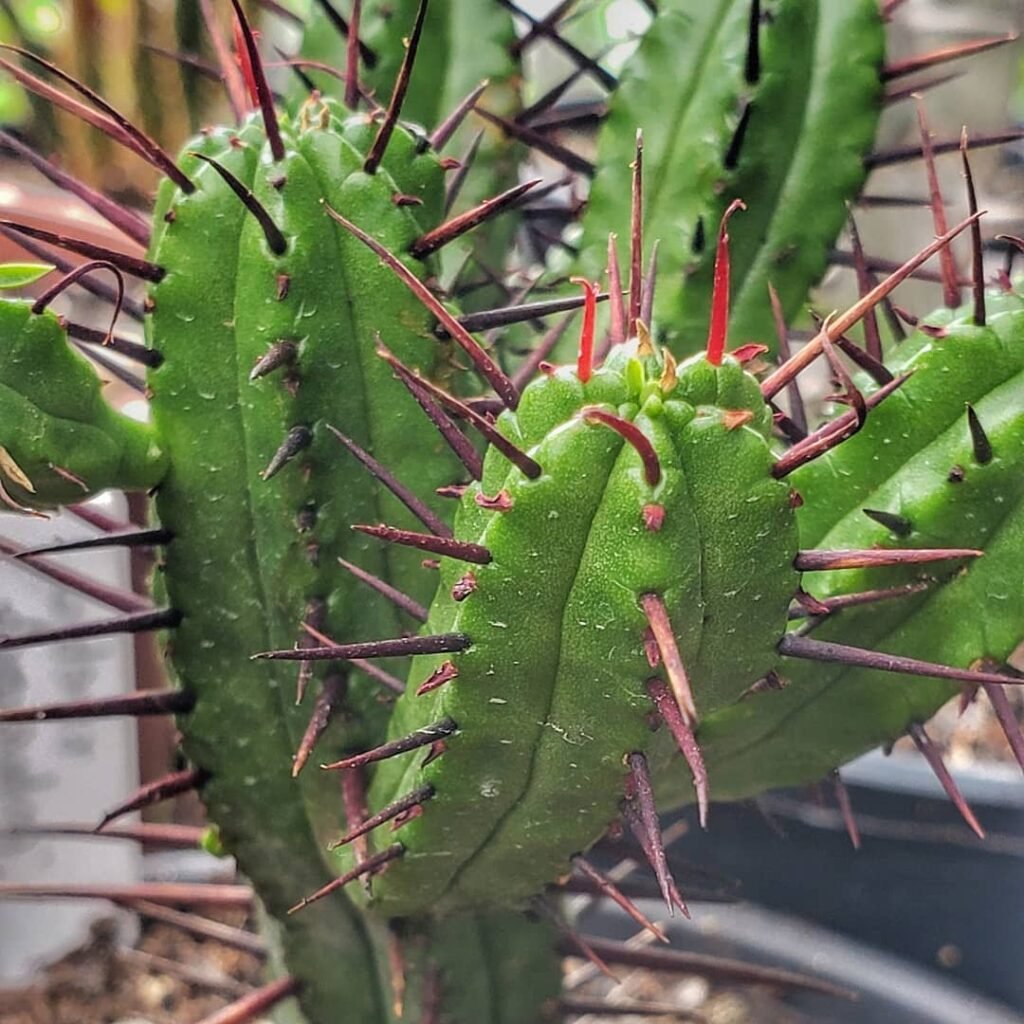Let me tell you about the time I decided my home needed a bit of a plant makeover. I was on the lookout for something different and eye-catching, a plant that would just fit right in with the vibe of my place. That’s when I stumbled across the gorgeous Euphorbia enopla, or as it’s also known, the Pincushion Euphorbia.
What really got me interested in this little succulent wasn’t just its bright and lively look but how tough it is. It’s a desert plant, right, so it’s all set for surviving in dry spots, which is brilliant for the often less than sunny UK weather. Its happy-go-lucky attitude towards drought meant I wouldn’t need to keep fussing over it. And to be honest, I’m not exactly the most diligent gardener around.
Bringing this Pincushion Euphorbia home, I was totally taken with its thick, spiky branches, all decked out in greens and yellows. It seriously looked like something out of a quirky fairy tale, adding a spot of exotic charm to my room. And who would have thought? Taking care of it turned out to be a breeze.
So, whether you’ve got green fingers or you’re just starting to dip your toes into the world of houseplants, the Euphorbia enopla is a fab pick. It’s easy to look after, and it’ll make any space pop with a bit of unique style.
Appearance of Euphorbia enopla (Pincushion Euphorbia)


Euphorbia enopla is a succulent plant that boasts a striking and unique appearance. It features thick branches adorned with vibrantly colored spines, giving it a pincushion-like resemblance. The spines of this desert plant are reminiscent of pins stuck into a cushion, which is why it is commonly known as “Pincushion Euphorbia.” The plant has a compact and rounded growth habit, reaching a height of up to 20 cm.
Euphorbia enopla is native to South Africa and has adapted to survive in arid conditions by storing water in its stems and leaves. This adaptation makes it highly drought-tolerant, making it an excellent choice for those seeking low-maintenance succulent plants.
 Here’s a quirky bit about Euphorbia enopla, or Pincushion Euphorbia: it’s not just another pretty face in the succulent world. This plant has a secret weapon – it produces a milky sap that’s quite bitter, making it the last choice for a snack in the wild. And, if you thought it couldn’t get any cooler, under the right conditions, it’ll surprise you with tiny, vibrant flowers that seem to pop up out of nowhere. It’s like nature’s own magic trick!
Here’s a quirky bit about Euphorbia enopla, or Pincushion Euphorbia: it’s not just another pretty face in the succulent world. This plant has a secret weapon – it produces a milky sap that’s quite bitter, making it the last choice for a snack in the wild. And, if you thought it couldn’t get any cooler, under the right conditions, it’ll surprise you with tiny, vibrant flowers that seem to pop up out of nowhere. It’s like nature’s own magic trick!
Light Requirements for Euphorbia enopla

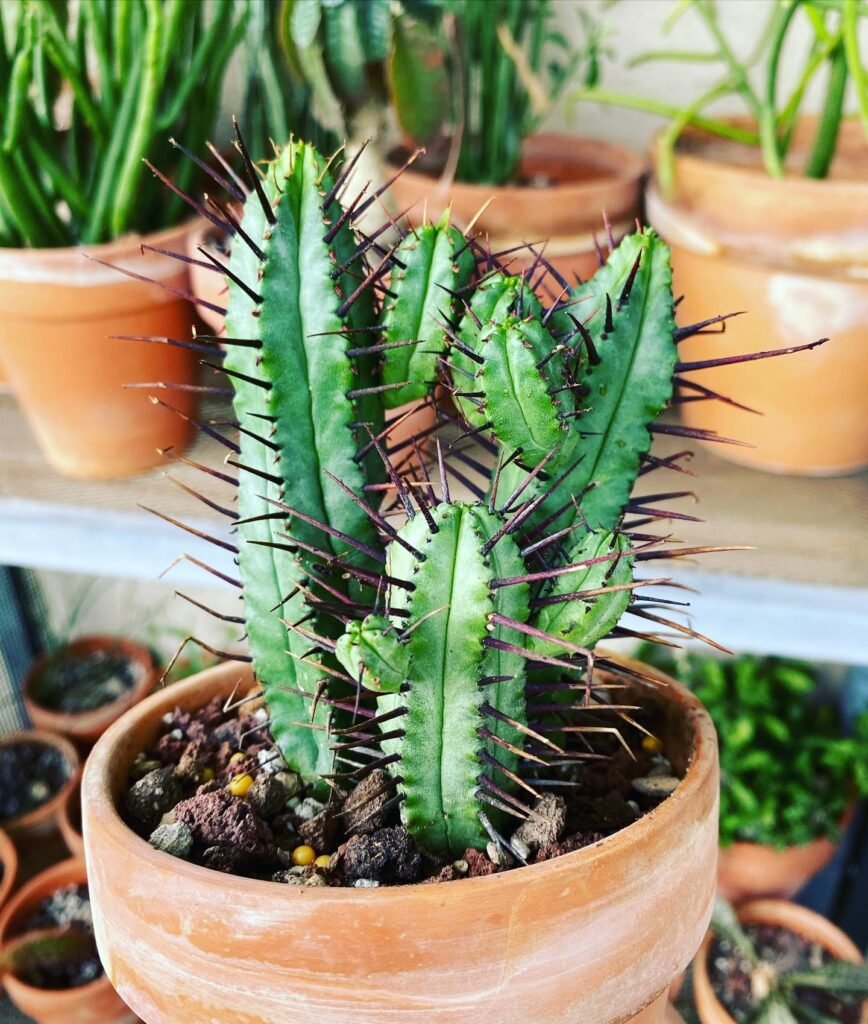
Euphorbia enopla, also known as Pincushion Euphorbia, is a succulent plant that thrives in bright, indirect sunlight. To ensure its optimal health, it’s important to place the plant in a location where it can receive plenty of natural light, such as near a sunny window. However, direct sunlight should be avoided as it can cause the plant to burn.
This unique succulent can tolerate some shade, but it requires a minimum of 4-6 hours of bright, indirect sunlight per day. The bright, indirect sunlight provides the energy the plant needs for photosynthesis and growth. Without sufficient light, Euphorbia enopla may become leggy and weak.
Remember, Euphorbia enopla thrives in bright, indirect sunlight to maintain its optimum health.
When choosing a spot for your Euphorbia enopla, consider a location that receives bright, indirect sunlight throughout the day. This could be near a south-facing or west-facing window. If your indoor space doesn’t provide enough light, you can supplement it with artificial grow lights specifically designed for succulent plants.
Overall, providing the right amount of light is crucial for the growth and well-being of Euphorbia enopla. With the proper exposure to bright, indirect sunlight, this succulent plant will thrive and showcase its unique beauty.

Watering Tips for Euphorbia enopla (Pincushion Euphorbia)
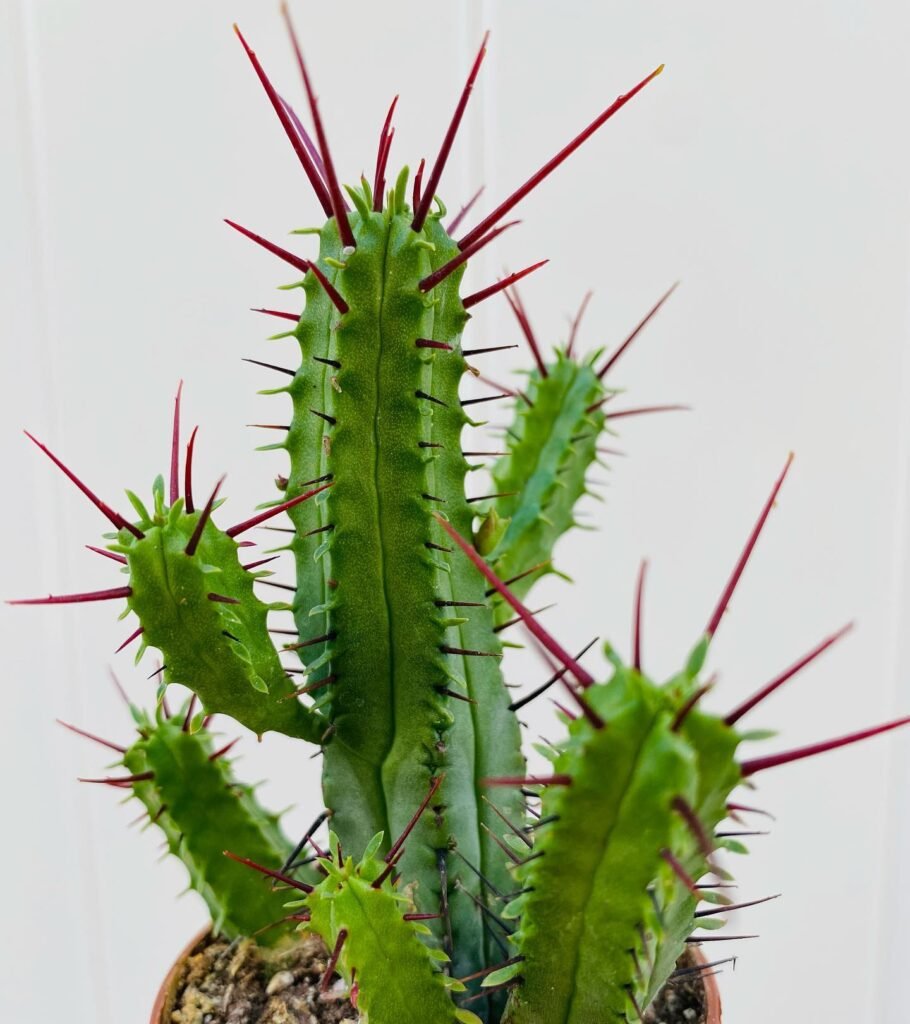
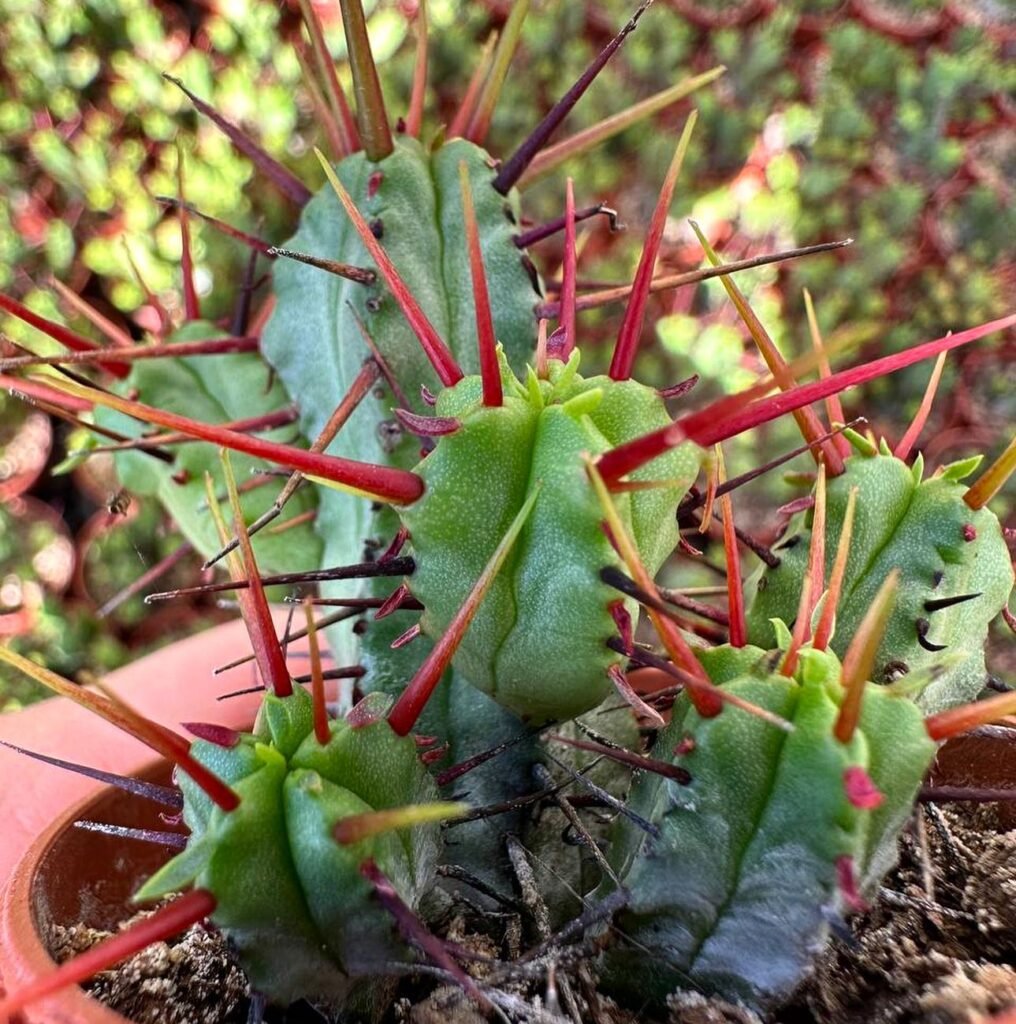
Euphorbia enopla is a succulent plant that is well-adapted to dry soil conditions and requires minimal watering. It is important to allow the soil to completely dry out between waterings to prevent overwatering, which can lead to root rot and other issues. When it comes to watering this drought-tolerant succulent, it’s best to err on the side of underwatering.
During the growing season, which is in spring and summer, it is generally recommended to water Euphorbia enopla every 2-3 weeks. However, it’s always best to check the soil moisture before watering to ensure it has fully dried out. In the dormant season, which is in autumn and winter, watering frequency should be reduced even further.
To determine if the plant needs watering, gently press your finger into the soil. If it feels dry to the touch, it’s time to water. Remember, it is better to underwater than to overwater this succulent.
When watering, aim to thoroughly moisten the soil without soaking it. It’s important to avoid getting water directly on the plant’s spines, as this can lead to rot or fungal problems. To prevent this, consider using a watering can with a narrow spout to target the soil directly.
By following these watering tips, you can ensure the health and longevity of your Euphorbia enopla (Pincushion Euphorbia) and enjoy its unique beauty in your garden or indoor space.

Fertilizing and Soil for Euphorbia enopla
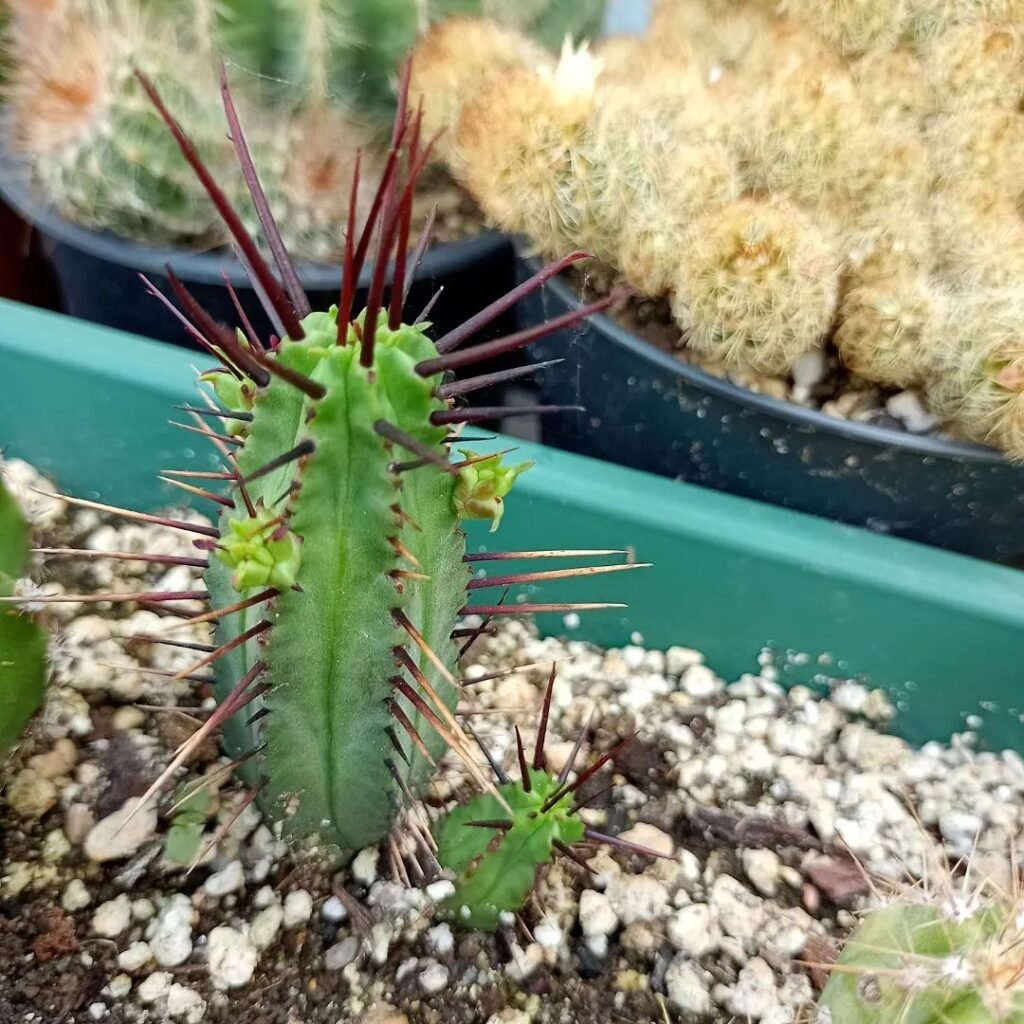

Euphorbia enopla, also known as Pincushion euphorbia, is a beautiful succulent plant that requires minimal fertilizing. To ensure its health and well-being, it is important to provide the plant with a well-draining soil mix that is specifically formulated for succulents. This type of soil allows for proper drainage, preventing the roots from sitting in excess moisture, which can lead to root rot.
When it comes to fertilizing Euphorbia enopla, less is more. Over-fertilizing can cause excessive growth and weaken the plant’s structure. During the growing season, which typically occurs in spring and summer, a balanced liquid fertilizer diluted to half strength can be applied once a month. This provides the plant with the necessary nutrients without overwhelming it.
It is important to carefully follow the manufacturer’s instructions when applying fertilizer, and not exceed the recommended dosage. Applying too much fertilizer can have detrimental effects on the plant’s health, so it is always better to err on the side of caution.
“A well-draining soil mix specifically formulated for succulent plants is best for Euphorbia enopla. Less frequent fertilizing is necessary to avoid excessive growth and weak structure. Follow the manufacturer’s instructions and avoid over-fertilizing.”

Pruning and Maintenance for Pincushion Euphorbia
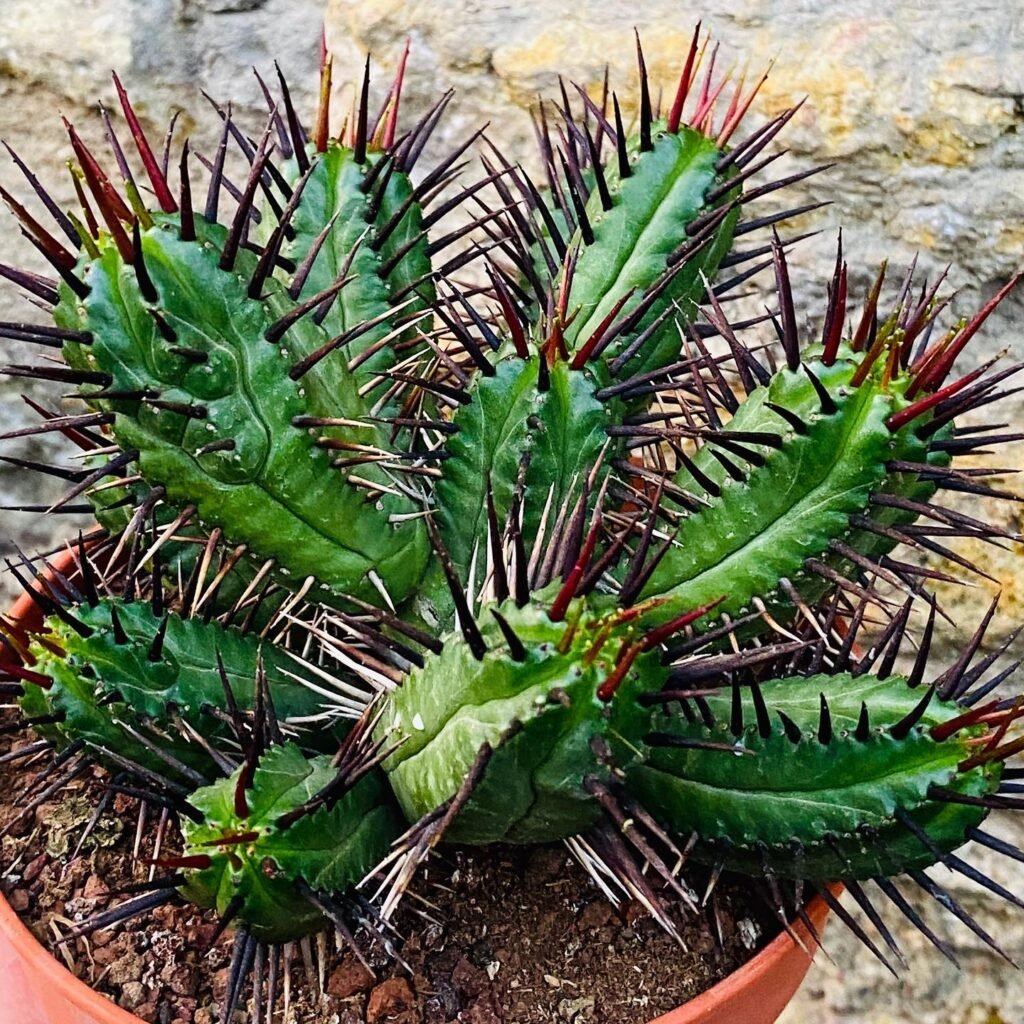
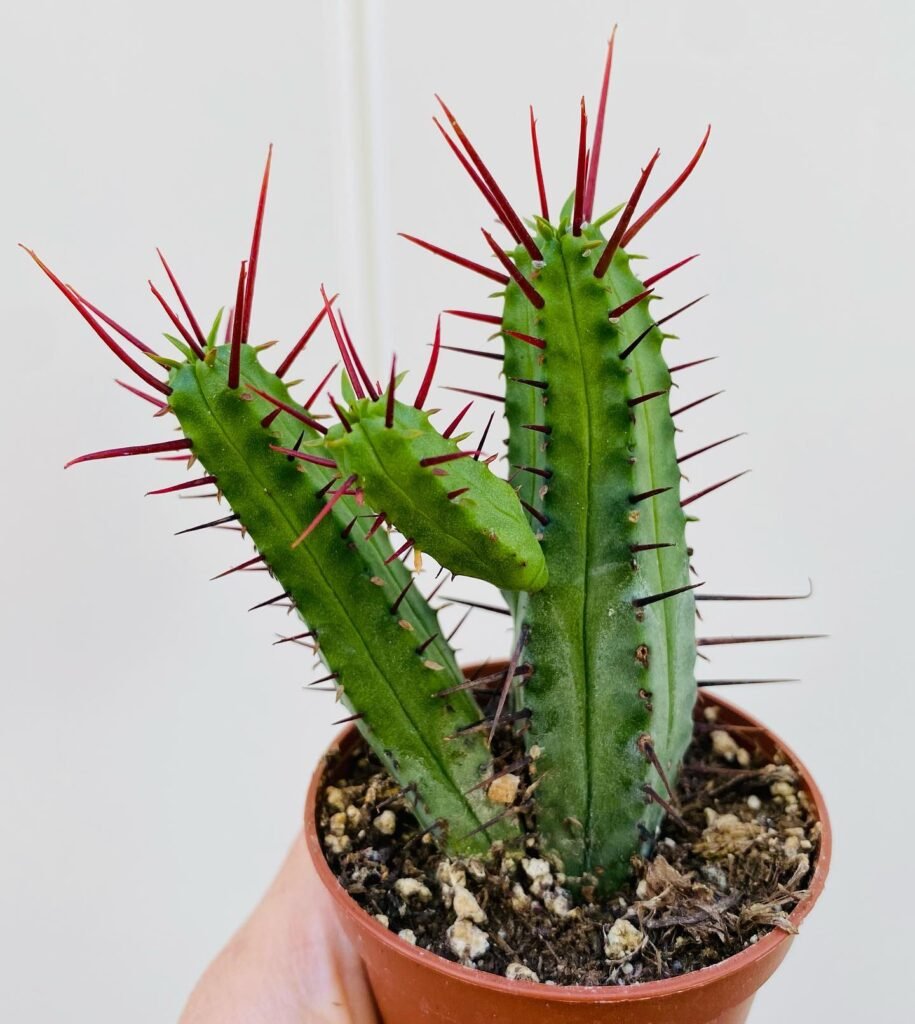
Euphorbia enopla, known as Pincushion Euphorbia, is a low-maintenance succulent plant that generally does not require much pruning. However, it is important to regularly inspect and remove any dead or damaged portions of the plant to maintain its overall health and appearance.
When pruning Euphorbia enopla, it is recommended to wear gloves to protect yourself from the sharp spines that cover its branches. This will help prevent any accidental injury and ensure a safe pruning experience.
In addition to pruning, regular maintenance is also essential for the proper care of Pincushion Euphorbia. Keeping the plant clean and free from dust will not only enhance its aesthetic appeal but also promote healthy growth.
Furthermore, it is important to inspect the plant regularly for any signs of pests or diseases. Early detection and appropriate action can help prevent the spread of infestations and maintain the plant’s vitality.
Monitoring the overall growth and condition of Euphorbia enopla is also crucial for its well-being. This includes observing its growth rate, checking for any abnormalities or discoloration, and ensuring it receives the right amount of light, water, and nutrients.

Propagating Euphorbia enopla (Pincushion Euphorbia)
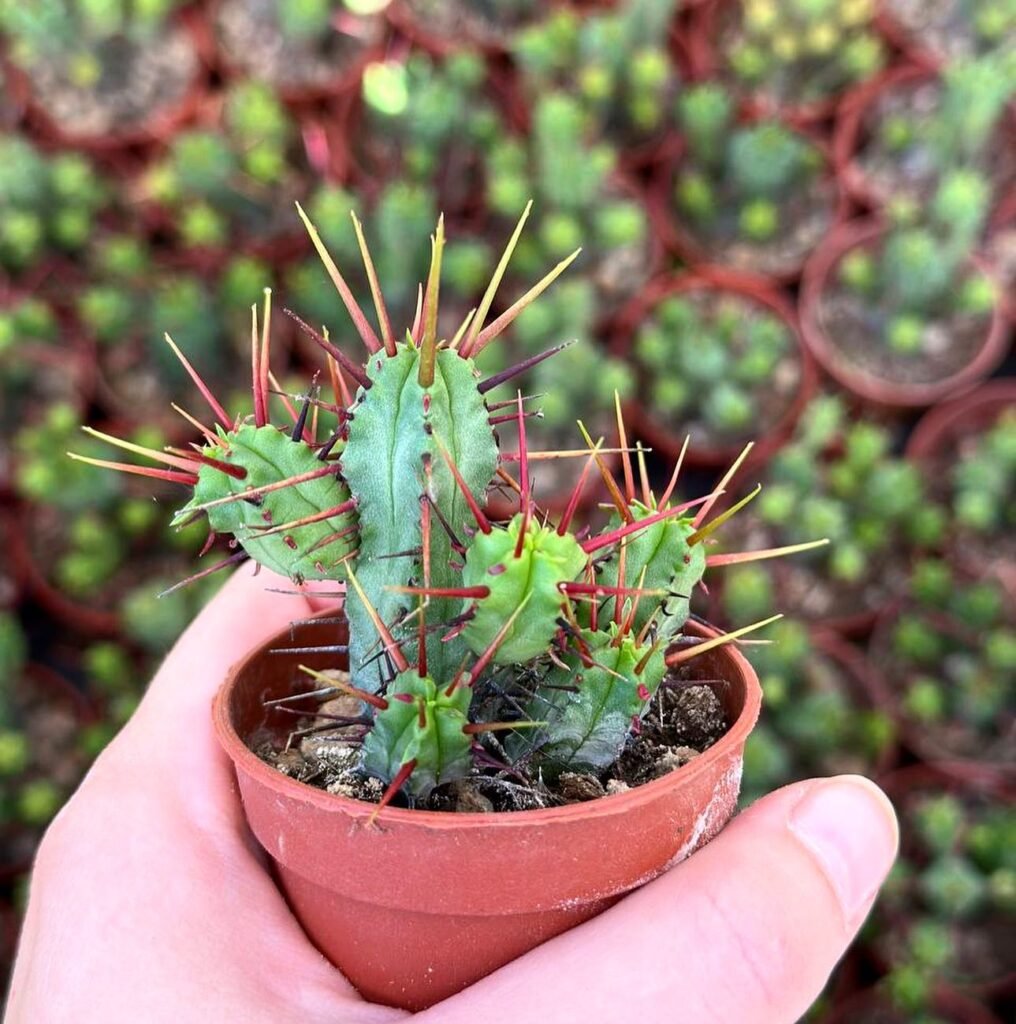

Euphorbia enopla, commonly known as Pincushion Euphorbia, can be easily propagated through stem cuttings or offsets. Here’s how you can expand your collection of these stunning succulent plants:
Propagating with Stem Cuttings
- Select a healthy stem from the parent plant, making sure it is free from any damage or diseases.
- Cut a section of the stem using a sharp, sterile blade. Ideally, the cutting should be about 10 cm in length.
- Allow the cuttings to dry in a shaded area for a few days. This step is crucial to prevent rot and promote callusing.
- Prepare a well-draining soil mix suitable for succulents.
- Plant the dried cutting in the soil, ensuring that at least one-third of the stem is buried.
- Water the cutting lightly, making sure not to oversaturate the soil.
- Place the pot in a bright location with indirect sunlight and maintain a warm temperature of around 20-25°C.
- After a few weeks, you should start to see new roots forming from the base of the cutting.
- Continue to care for the new plantlet as you would for a mature Pincushion Euphorbia.
Propagating with Offsets
Euphorbia enopla naturally produces offsets, which are small plantlets that grow from the base of the parent plant. These offsets can be gently removed and replanted to create new individuals. Follow these steps:
- Identify a mature offset that has developed its own root system.
- Using a sterile tool, carefully separate the offset from the parent plant, ensuring that it retains its roots.
- Allow the cut end of the offset to dry and callus for a few days.
- Choose a well-draining succulent soil mix and plant the offset, burying the roots in the soil.
- Water the newly planted offset lightly and place it in a suitable location with bright, indirect sunlight.
- Maintain the proper watering and care routine to ensure the successful establishment and growth of the offset.
Remember, whether you choose to propagate using stem cuttings or offsets, it’s important to let the cut ends dry and callus before planting. This will help prevent moisture-related issues and promote successful rooting. Enjoy the rewarding experience of propagating your own Euphorbia enopla and watch your Pincushion Euphorbia family flourish!

Repotting Tips for Euphorbia enopla
Repotting your Euphorbia enopla, also known as Pincushion Euphorbia, is essential every 2-3 years to provide fresh soil and create space for growth. Follow these tips to ensure a successful repotting process:
- Choose the right pot with drainage holes: Look for a pot that has adequate drainage holes to prevent water from accumulating at the bottom. This will help avoid issues such as root rot.
- Opt for well-draining soil mix: Use a well-draining soil mix specifically formulated for succulent plants. This type of soil allows excess water to drain quickly, preventing the roots from being too wet.
- Consider pot size: Select a new pot that is slightly larger than the current one. This will give your Euphorbia enopla enough room to grow and develop a robust root system.
- Handle with care: The spines of the Euphorbia enopla can cause skin irritation. It’s recommended to wear gloves during the repotting process to protect yourself from any potential harm.
“Repotting Euphorbia enopla allows for fresh soil and ample space, ensuring its healthy growth and longevity.”
By following these repotting tips, you can provide your Euphorbia enopla with the optimal conditions it needs to thrive. Enjoy the process of repotting and witnessing your succulent plant flourish in its new home!
 Did you know that Euphorbia enopla, also known as Pincushion Euphorbia, is a marvel of nature’s design? Its spiny appearance isn’t just for show; those spines actually help to collect moisture from the air, making it supremely adapted to survive in arid environments. This unique survival strategy not only showcases the plant’s resilience but also its clever adaptation to thrive with minimal water.
Did you know that Euphorbia enopla, also known as Pincushion Euphorbia, is a marvel of nature’s design? Its spiny appearance isn’t just for show; those spines actually help to collect moisture from the air, making it supremely adapted to survive in arid environments. This unique survival strategy not only showcases the plant’s resilience but also its clever adaptation to thrive with minimal water.
FAQ about Caring for Euphorbia enopla (Pincushion Euphorbia)

Fancy giving your Euphorbia enopla (Pincushion Euphorbia) the best life? Dive into my easy-to-follow FAQ for all the top tips on caring for your Pincushion Euphorbia. Whether it’s finding the perfect spot in your house or getting the watering just right, I’ve got you covered to help your plant thrive.
Euphorbia enopla thrives in well-draining soil. A mixture of cactus potting soil and perlite or sand is ideal for ensuring proper drainage.
It requires full sun to partial shade. In the UK climate, a south-facing window is perfect for providing the bright light it needs.
Water when the soil completely dries out, typically every 1-2 weeks during the growing season and less frequently in winter.
No, it’s not frost-tolerant. Bring it indoors or provide protection when the temperature drops below 10°C.
Repot in spring or early summer when the plant shows signs of outgrowing its current pot or the soil needs refreshing.
Yes, but it should be in a pot for easy movement indoors during cold months or grown in a sheltered, sunny spot that doesn’t get frost.
Use a balanced, water-soluble fertiliser diluted to half strength, once a month during the growing season.
Propagate by cuttings. Take stem cuttings in spring or summer, allow them to callous over for a few days before planting in well-draining soil.
Inspect regularly for pests like mealybugs and treat with insecticidal soap or neem oil as needed.
Minimal pruning is needed, mainly to remove any dead or damaged parts to maintain plant health and appearance.
Euphorbia sap can be irritating. Wear gloves when handling or pruning and wash hands thoroughly afterwards.
Yes, though it prefers dry conditions. Ensure good air circulation if growing indoors to mimic its natural arid habitat.
It can reach up to 60 cm in height and spread similarly, depending on the pot size and growing conditions.
Absolutely, its care is straightforward, making it a great choice for those new to gardening.
While blooming is rare in cultivation, providing optimal care with plenty of sunlight increases your chances.
A sunny windowsill, conservatory, or a greenhouse where it can get plenty of light is ideal.
I trust this has set you up nicely to care for your Euphorbia enopla (Pincushion Euphorbia). Should there be any lingering questions, don’t hesitate to leave them in the comments. I’m eager to assist further. Remember, every gardener’s journey begins with a single step, and getting to know your Pincushion Euphorbia is all part of the adventure.
Final Thoughts on Caring for Euphorbia enopla
Caring for Euphorbia enopla in the UK is a breeze. This succulent plant is low-maintenance and perfectly suited to the UK climate. With its ability to thrive in bright, indirect sunlight, it can bring a touch of natural beauty to both indoor and outdoor spaces.
When it comes to watering, Euphorbia enopla is quite forgiving. Its drought-tolerant nature means that it requires minimal watering. Simply wait for the soil to dry out completely before giving it a drink. This makes it an ideal choice for those who may not have a green thumb or who are looking for a low-maintenance plant.
In terms of care, occasional fertilizing during the growing season can help keep your Euphorbia enopla healthy and vibrant. Using a well-draining soil mix specifically formulated for succulents will ensure that the plant receives the proper nutrients and avoids any risk of overwatering.
Lastly, it’s important to handle Euphorbia enopla with care due to its spines. Remember to wear gloves when working with the plant to avoid any potential skin irritation. By following these simple care tips, you can enjoy the unique beauty of Euphorbia enopla in your UK garden or indoor space.

